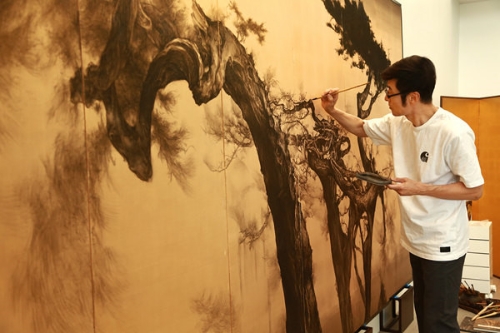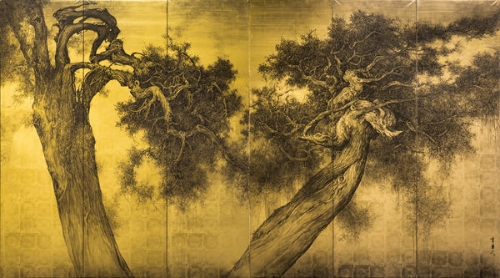Peak Perfection
Ink painting is a quiet art form, like the moon, while Western art is strong and vigorous, like the sun.
Li Huayi's solo exhibition combines his love for landscapes with a mastery of both modern and traditional painting techniques. Deng Zhangyu reports.
Ink painter Li Huayi's landscape paintings appear to be a mix of traditional Chinese style and Western modernism, much like the Suzhou Museum - a building designed by Chinese-American architect I.M.Pei that fuses elements from both East and West - where the Shanghai native's solo show opened recently.
On display are 18 large landscape paintings - many are several meters long - that the 69-year-old has produced over the past decade. The exhibition, entitled Fantasies on Paper and Enchantments in Gold, includes many of the artist's iconic landscapes on paper and more recent works using gilded screens as a medium.
The San Francisco-based artist's works are widely collected by such Western museums as the British Museum, Harvard Art Museums and the Cleveland Museum of Art. Many of his paintings have fetched hundreds of thousands of dollars at international auctions in recent years.
Li is regarded as ranking among a handful of influential artists whose ink paintings resemble those of the masters of the Song Dynasty (960-1279). Landscapes by artists from this era have long been regarded as the best of their kind in Chinese art history.
Chen Ruijin, director of the Suzhou Museum, says that the high mountains, ancient trees, rugged crags and cliffs found in Li's works often remind viewers of art from this period. Yet, on closer inspection, Chen believes Li's technique of combining elements from modern Western art with traditional Chinese ink painting are soon revealed.
Li, who was born in 1948 to a rich family in Shanghai, started to learn ink painting from the age of 6 under Wang Jimei, son of one of Shanghai's most renowned traditional painters, Wang Zhen. Ten years later, he began to study Western art with Zhang Chongren, a graduate of the Belgian Royal Academy of Fine Arts.
In 1982, Li moved to San Francisco and later obtained his art degree from the Academy of Arts before settling down in the coastal city.
"It was very easy for me to appreciate Chinese masters' ink paintings collected by museums in the US. I often visited their art exhibitions in order to see these paintings," Li says.
With his knowledge of Eastern and Western art, Li compares Chinese ink painting to Western abstract expressionist art, which both aim to express the artists' sentiments via the depiction of landscapes.
Li's paintings mainly focus on the subjects of mountains, trees, waterfalls and mist, which are reinterpreted by the artist after countless visits to mountain ranges around China and abroad.
Before the opening of his solo show in late September, Li visited the world's highest peak, Qomolangma, known as Mount Everest in the West. The 69-year-old said he was not strong enough to climb to the summit, but he tried to see as much as possible during his stay in its foothills. As with other mountains he has visited, the artist says he enjoys the process of climbing and absorbing picturesque landscapes.
His favorite peak, Huangshan Mountain in Anhui province, draws tourists from around China and the rest of the world and is famous for its attractive pine trees.
"Huangshan Mountain is like a work by a designer. There are no weeds on the rocks and the pine trees have a very unique look," Li says.
And that is how the artist unveils his reimagined landscapes on his paper and gilded screens - crooked trees clinging to rugged cliffs.
Catherine Kwai, founder of the Kwai Fung Hin art gallery that's presenting Li's solo show, says Li usually embarks on a trip to the mountains after finishing a work. An old friend of Li, Kwai jokes that he is too slow at painting because he has only completed no more than 400 works over the past 60 years.
"He is very meticulous in his painting. It's incredible to see the detail he puts into each leaf, even when the scroll is several meters long," says Kwai.
Li explains his painting process is more like an exercise in practice, where the act of repetition allows him to fuse his own sentiments into each stage of the painting through his brush strokes.
Several years ago, Li set up a studio in Beijing outside of his base in San Francisco. His work space is downtown, near the landmark China Central Television Tower.
"Many friends say that, although Beijing lies beyond my studio's curtains, inside is totally my quiet space," Li says.
He prefers solitude when working in the city and enjoys the peacefulness of the painting process. He seldom attends parties and typically enjoys his own company.
This is reflected in Li's works, which contain no traces of human beings or their impact on the landscapes. Li's protagonists are trees, stones and water. The artist jokes that this is because he needs peace to work - and people are always noisy.
"Ink painting is a quiet art form, like the moon, while Western art is strong and vigorous, like the sun," Li explains.





